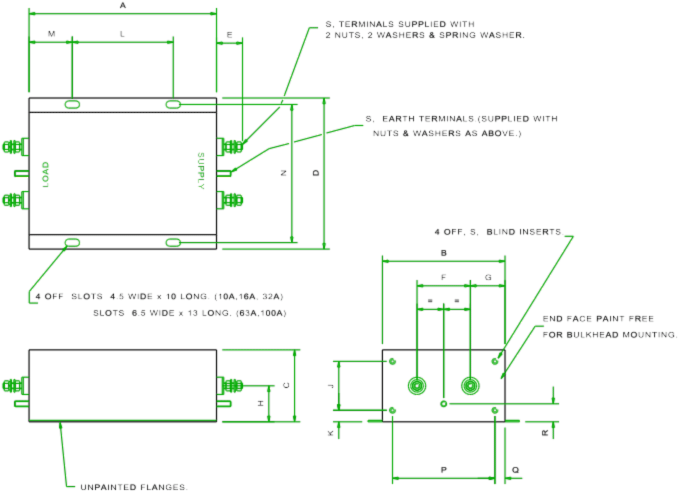High Current Equipment Filters (three-phase)
This range of high current equipment filters is suitable for a wide variety of EMC applications where high performance filtering of single phase ac mains lines is required. The filters incorporate feedthrough capacitors to give excellent high frequency performance. They are designed for either bulkhead or chassis mounting for optimum flexibility although maximum performance will only be achieved when bulkhead mounted. Self-healing metallised plastic film capacitors are used for maximum reliability and safety. This range of filters is intended for use in a permanently earthed application and complies with the proof voltage requirements of EN133200.

| Rated Voltage | 250V ac 50/60Hz, 250Vdc | |
| Test Voltage | (line – earth) | 2250V dc |
| (line – line) | 1250V dc | |
| Rated Current, IR | As tabulated | |
| Insertion Loss (50Ω, asymmetric) | 100dB from 300kHz to 1GHz | |
| Maximum Full Load Heat Dissipation | As tabulated | |
| Maximum Temperature Rise at Full Load | 25ºC | |
| Ambient Temperature Range | -25ºC to +85ºC | |
| Maximum Leakage Current (at 250V 50Hz) | 125mA | |
| Maximum Heat Dissipation | As Tabulated | |
| Maximum Discharge Time to below 34V | 2 Seconds | |
| Part Number | Current Rating IR (A) @50ºC* | Maximum Heat Dissipation (W) | Major Dimensions (mm) | Weight (Kg) | ||
|---|---|---|---|---|---|---|
| Length A | Width B | Depth C | ||||
| DS29000 | 10 | 2 | 105 | 85 | 50 | 0.75 |
| DS29001 | 16 | 3 | 105 | 85 | 50 | 0.75 |
| DS29002 | 32 | 5 | 130 | 85 | 50 | 1 |
| DS29003 | 63 | 11 | 170 | 100 | 70 | 2 |
| DS29004 | 100 | 24 | 220 | 110 | 85 | 2.5 |
*Current derating between 50ºC and 85ºCFor temperature, θ Iθ = IR

| Part Number | |||||||||||||||||
|---|---|---|---|---|---|---|---|---|---|---|---|---|---|---|---|---|---|
| A | B | C | D | E | F | G | H | J | K | L | M | N | P | Q | R | S | |
| DS29000 | 105 | 85 | 50 | 105 | 18 | 37 | 24 | 25 | 34 | 8 | 55 | 25 | 96 | 71 | 7 | 12.5 | M4 |
| DS29001 | 105 | 85 | 50 | 105 | 18 | 37 | 24 | 25 | 34 | 8 | 55 | 25 | 96 | 71 | 7 | 12.5 | M4 |
| DS29002 | 130 | 85 | 50 | 105 | 18 | 37 | 24 | 25 | 34 | 8 | 70 | 30 | 96 | 71 | 7 | 12.5 | M4 |
| DS29003 | 170 | 100 | 70 | 128 | 32 | 40 | 30 | 40 | 50 | 10 | 90 | 40 | 114 | 76 | 12 | 20 | M6 |
| DS29004 | 220 | 110 | 85 | 138 | 32 | 45 | 32.5 | 50 | 65 | 10 | 120 | 50 | 124 | 86 | 12 | 25 | M6 |
The chassis and/or bulkhead should be a flat clean paint-free metal surface to provide a good low impedance earth bond. Recommended thread tightening torques: M4: 1.2 N-m M6: 2.5 N-m
These filters must be solidly and permanently earthed via the chassis mounting, the bulkhead mounting, or via the earth screw provided. Terminals must be suitably enclosed by the user. These filters are fitted with discharge resistors, but the user must still ensure that the capacitors are safely discharged prior to touching terminals.